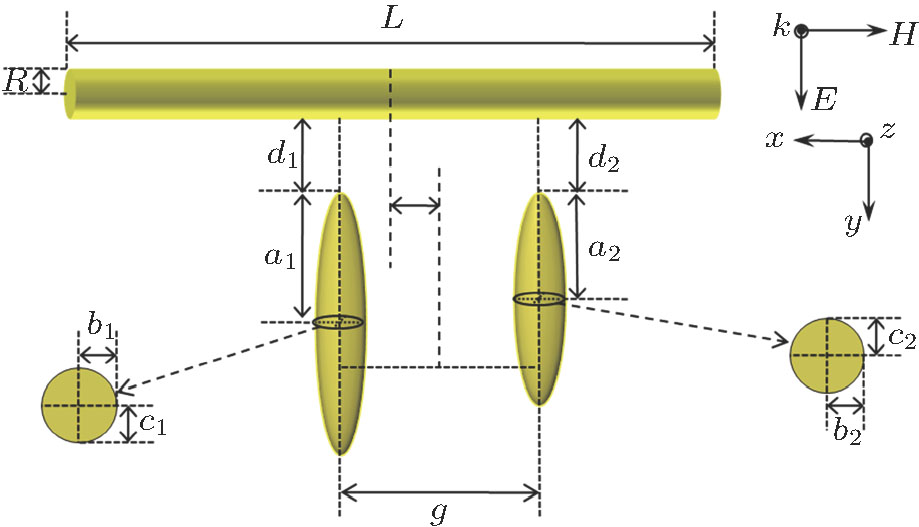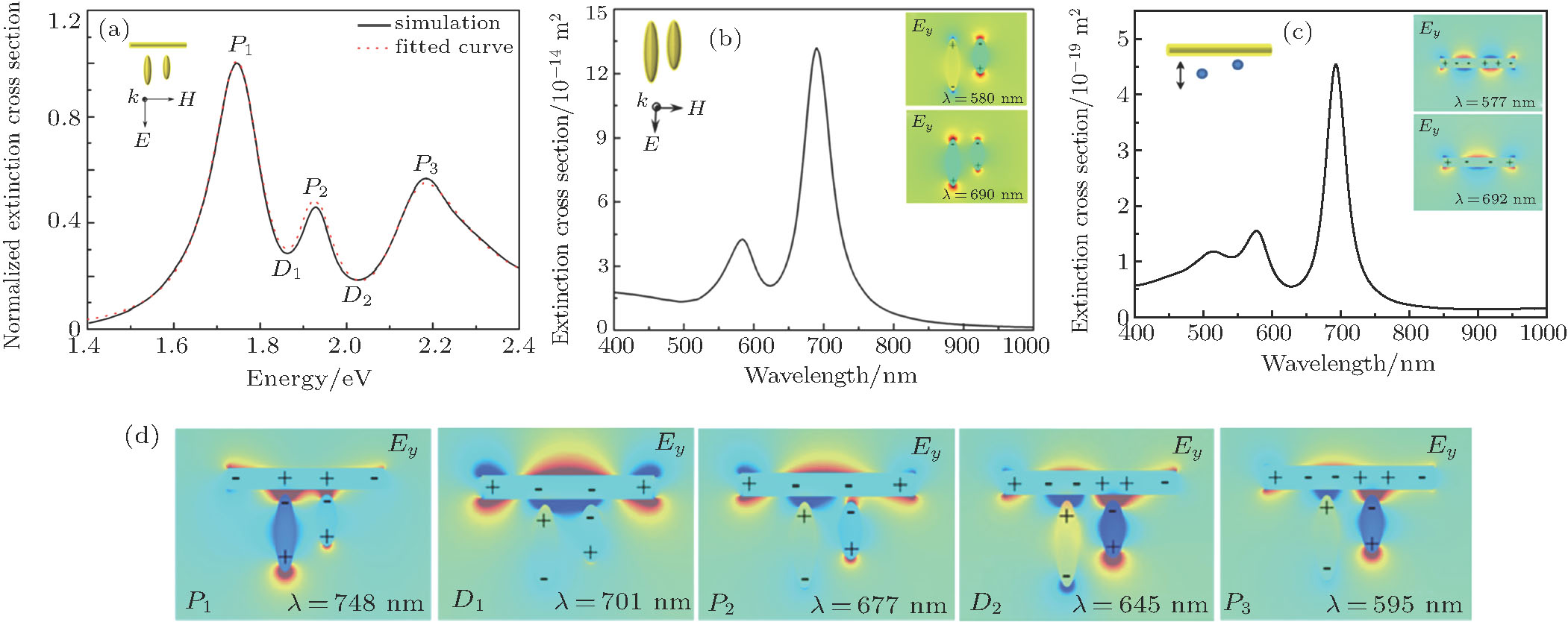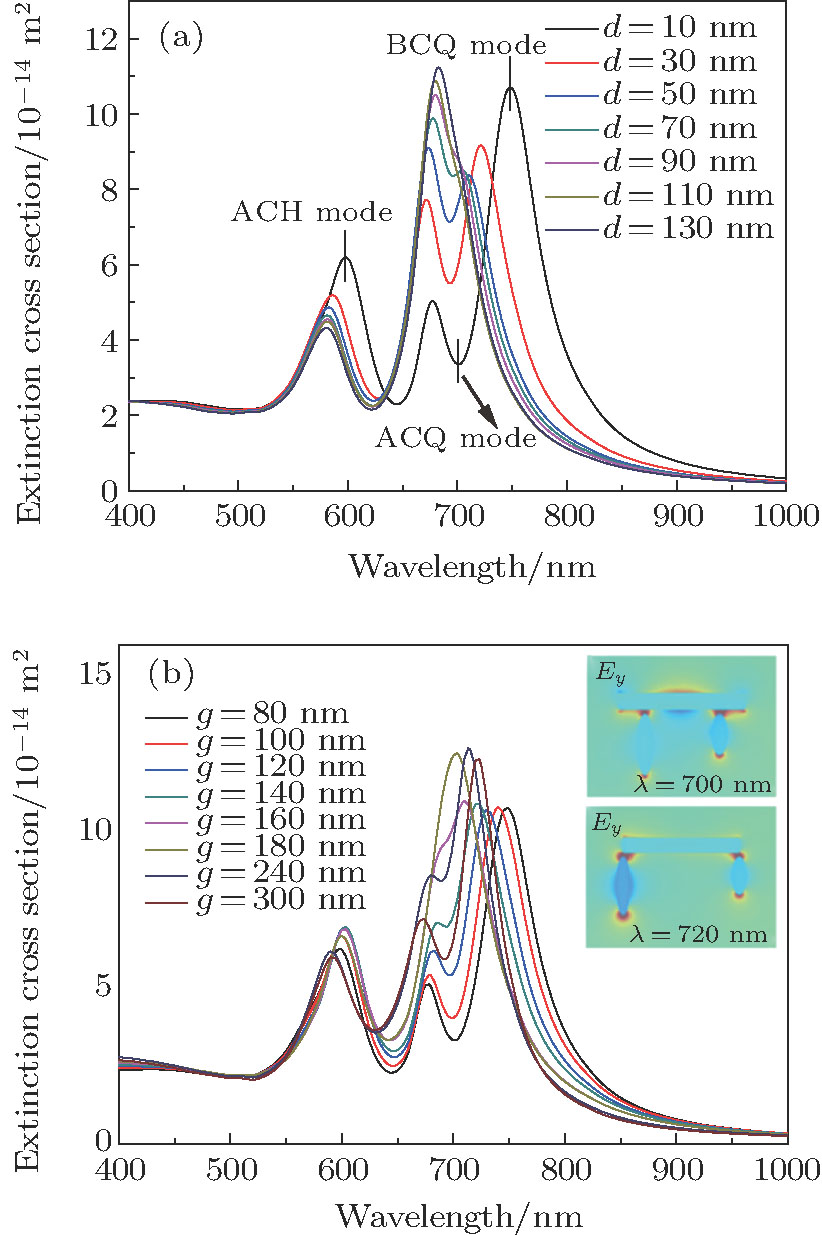

† Corresponding author. E-mail:
Fano interference of metallic nanostructure is an effective way to reduce the irradiation loss and improve the spectral resolution. A Π-shaped gold nano-trimer, which is composed of a gold nanorod and two gold nanorices, is presented to investigate the properties of Fano resonances in the visible spectrum by using the finite element method (FEM). The theoretical analysis demonstrates that the Fano resonance of the Π-shaped gold nano-trimer is attributed to the near-field interaction between the bright mode of the nanorice pair and the dark quadrupole mode of the nanorod. Furthermore, by breaking the geometric symmetry of the nanostructure the line-shape spectrum with double Fano resonances of Π-shaped gold nano-trimer is obtained and exhibits structure-dependent and medium-dependent characteristics. It is a helpful strategy to design a plasmonic nanostructure for implementing multiple Fano resonances in practical applications.
As is well known, Fano resonance is due to the interaction between a continuum of states (background scattering process) and a discrete state (resonant scattering process) producing an asymmetric line-shape spectrum,[1] which can be found in many physics and engineering fields.[2–4] Especially, Fano resonance in metallic nanostructures has attracted more attention due to its numerous benefits for designing photonic devices, such as greatly enhancing the electromagnetic fields localized on the surface of metallic nanostructures,[5] effectively reducing the radiation damping of metal geometry,[6] and vastly inducing the nonlinear effect of materials containing metal nanoparticles.[7] In recent decades, a variety of metallic nanostructures have been proposed to investigate Fano resonances, such as core-shell nanostructures,[8–10] ring-disk cavities,[11–18] nanoparticle dimers,[19–21] nanoparticle trimers,[22,23] and the multimeric nanoclusters.[24–26] Metallic nanostructures have exhibited significant potential applications in photonic devices, such as SERS-based optical sensors,[17,23] spaserbased laser,[27] optical switchers,[28] slow light devices,[29] and resonators with an electromagnetically inducing transparency(EIT)like property.[13,30] Novel metallic nanostructures are expected to be designed and fabricated to demonstrate the excellent functional characteristics of Fano resonance.
In general, a complex noble metal nanostructure can exhibit unique and colorful localized surface plasmon resonance(LSPR) properties under the irradiation of an incident lightwave.[31] According to the plasmon hybridization theory,[32] the extinction spectrum of the noble metal nanostructure can be destructed into the overlap of two or more LSPR bands through the near-field interactions. Further, when the plasmon hybridization between a board bright plasmon mode and a relatively narrow dark plasmon mode happens, a board LSPR band and a relative narrow LSPR band overlap an extinction spectrum with an asymmetric line shape that can be obtained to display the characteristics of Fano resonance, which is dependent on the morphology configurations of the metallic nanostructure.
In terms of the fabrication technique, although some nanostructures composed of nanoparticles can be easily synthesized by the chemical method, the gap distances between nanoparticles and the sizes of nanoparticles are very difficult to control the Focusing ion beam (FIB) method[33] or the electron beam lithography (EBL) method[34] can be used to fabricate more complex nanostructures by controlling the desired pattern, such as the ring-disk nanostructure[12] and nanoclusters,[35] which provides more possibilities and conveniences to study a variety of complex nanostructures theoretically and experimentally. In recent years more delicate metal nanostructures, such as multimer have been proposed to obtain multiple Fano resonances.[36] Compared with single Fano resonance, multiple Fano resonances have several resonant dips which can easily achieve the controllable spectra by adjusting the structure configuration, and the electromagnetic field can be tremendously enhanced at different wavelengths. As a practice example, with the help of the multiple Fano resonances, the Raman spectra of molecules adsorbed on the surface of plasmonic nanostructure can be enhanced efficiently to detect different molecules by matching the different molecules.[37,38]
In our research, a gold nanoparticle system with a Π-shaped trimer composed of a nanorod and two nanorice is proposed to demonstrate the LSPR spectra with Fano resonances. For the symmetric Π-shaped trimer, the extinction spectrum exhibits a single Fano line shape, which originates from the near field coupling between the “bright” dipole mode of the double nanorices and the “dark” quadrupole mode of the nanorod. When the symmetry of the trimer is broken by adjusting the geometry parameters of the nanostructure, double Fano resonances can be formed due to the multiform plasmonic couplings between the modes supported by the asymmetric Π-shaped nanoparticles. The dependence of the double Fano resonance line shape on the refractive index of the surrounding medium is also investigated.
Figure 


As an effective and high accuracy formulation tool, the finite element method (FEM) is usually used to analyze the optical properties of metallic nanostructures by solving the scattering fields in the frequency domain. Here, we use FEM to calculate the distribution of near-field intensity and the spectra of extinction cross sections of the gold-nanoparticles system shown in Fig. 








In our simulation, the computation domain includes the rod-rice nano-trimer, a region of free space filled with medium surrounding the nano-system, a far-field transform boundary enclosing the whole system for calculating 

As is well known, Fano resonances in the range of the visible spectrum will be significant for the practical applications of biophotonics.[42] For the proposed Π-shaped trimer, the suitable structure parameters are designed to adjust the line shape of Fano resonances to be landed in the range of the visible spectrum. The geometric parameters of the Π-shaped trimer are set to be as follows: L=300 nm, R=20 nm, 




For the Π-shaped trimer, the nanorice pair induces a broad coupling mode (“bright” mode) and excites the narrow quadrupole resonance peak (“dark” mode) of the nanorod by near-field coupling. The excitation process of the trimer mode can be visually expressed as two pathways: direct and indirect excitations, i.e., 











In order to quantify the line widths of the BDQ and ADQ resonances an analytical Fano interference model is used to fit the extinction spectrum[44]










In order to further study the optical properties of the proposed Π-shaped nanostructure, we change the polar radius 













For a better insight into the formation of the double Fano resonances, the interaction between the “bright” mode and “dark” mode originating from asymmetry Π-shaped trimer nanostructure is explored. Figure 
Moreover, Figure 



For the BCQ peak, the quadrupole mode of the nanorod drives the dipolar charge oscillation in the bonding mode of the nanorice pair in phase, thereby reducing the restoring force and lowering the resonant energy compared with those of the single bonding mode of the nanorice pair and the quadrupole mode of the nanorod. That is why the resonant wavelength of the BCQ peak is greater than those of the bonding mode of the nanorice pair and the quadrupole mode of the nanorod; it is the same reason why the resonant wavelength of the ACH peak is greater than those of the antibonding mode of the nanorice pair and the hexapole mode of the nanorod. For the ACQ peak, the interaction between the antibonding mode of the nanorice pair and the quadrupole mode of the nanorod is weak, and there is a relatively small shift of the ACQ peak with respect to the quadrupole peak of the nanorod.
In order to investigate the dependence of the double Fano resonances on the geometry parameters of the asymmetric Π-shaped trimer, by adjusting the sizes of nanoparticles, the extinction spectra of asymmetric structure are obtained and shown in Fig.
Both ACQ mode and BCH mode increase their intensities with the increasing of polar radii of two nanorice as shown in Fig.
On the other hand, the double Fano resonances are also dependent on the distances among the nanoparticles. Figure 
The distance between two nanorice grains also affects the double Fano resonances of the asymmetric Π-shaped trimer. As shown in Fig.
In general, the Fano resonance of the metal nanostructure is intensely sensitive to the surrounding medium because the plasmonic resonance of the metal nanostructure depends on the permittivity of the surrounding medium. The extinction spectra of the proposed asymmetric Π-shaped trimer surrounded by media with different refractive indices are shown in Fig. 


In this work a Π-shaped nano-trimer is proposed to produce strong Fano resonance. The single Fano resonances of the symmetric Π-shaped trimer and the double Fano resonance of the asymmetric Π-shaped trimer are respectively investigated by analyzing the interferences among the dark quadrupole mode of the nanorod, the bright dipole plasmonic modes of the nanorice pair, and higher “dark” modes of the nanorod generated from the different hybridized modes of the nanorice pair. The simulation results demonstrate the structure-dependent and the medium-dependent characteristics of the double Fano resonance. Following this design idea, multiple Fano resonances are obtained for the multiple wavelength active plasmonic switching, SERS, and bio-sensing applications.
| [1] | |
| [2] | |
| [3] | |
| [4] | |
| [5] | |
| [6] | |
| [7] | |
| [8] | |
| [9] | |
| [10] | |
| [11] | |
| [12] | |
| [13] | |
| [14] | |
| [15] | |
| [16] | |
| [17] | |
| [18] | |
| [19] | |
| [20] | |
| [21] | |
| [22] | |
| [23] | |
| [24] | |
| [25] | |
| [26] | |
| [27] | |
| [28] | |
| [29] | |
| [30] | |
| [31] | |
| [32] | |
| [33] | |
| [34] | |
| [35] | |
| [36] | |
| [37] | |
| [38] | |
| [39] | |
| [40] | |
| [41] | |
| [42] | |
| [43] | |
| [44] | |
| [45] | |
| [46] | |
| [47] |



















